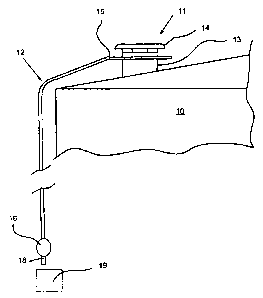Some of the information on this Web page has been provided by external sources. The Government of Canada is not responsible for the accuracy, reliability or currency of the information supplied by external sources. Users wishing to rely upon this information should consult directly with the source of the information. Content provided by external sources is not subject to official languages, privacy and accessibility requirements.
Any discrepancies in the text and image of the Claims and Abstract are due to differing posting times. Text of the Claims and Abstract are posted:
| (12) Patent: | (11) CA 2176158 |
|---|---|
| (54) English Title: | GAS SENSING SYSTEM |
| (54) French Title: | DISPOSITIF DE DETECTION DE GAZ DELETERES |
| Status: | Term Expired - Post Grant Beyond Limit |
| (51) International Patent Classification (IPC): |
|
|---|---|
| (72) Inventors : |
|
| (73) Owners : |
|
| (71) Applicants : |
|
| (74) Agent: | SANDER R. GELSINGGELSING, SANDER R. |
| (74) Associate agent: | |
| (45) Issued: | 2005-10-11 |
| (22) Filed Date: | 1996-05-09 |
| (41) Open to Public Inspection: | 1997-11-10 |
| Examination requested: | 2003-02-28 |
| Availability of licence: | N/A |
| Dedicated to the Public: | N/A |
| (25) Language of filing: | English |
| Patent Cooperation Treaty (PCT): | No |
|---|
| (30) Application Priority Data: | None |
|---|
The invention relates to apparatus used for the detection of hazardous vapours or gases and includes a length of tubing, a first portion of the tubing provided with a number of spaced apart orifices, that first part of the tubing being located adjacent to or associated with a source of, for example, H2S gas. The tubing is connected to a pump which is associated with gas detection apparatus.
L'invention concerne un appareil servant à détecter les vapeurs ou gaz nocifs et qui comprend une longueur de conduite, une première partie de la conduite étant pourvue d'un certain nombre d'orifices espacés, ladite première partie de la conduite étant située adjacente à une source de gaz, par exemple du H2S, ou bien étant associée à cette source. La conduite est raccordée à une pompe qui est associée à l'appareil de détection de gaz.
Note: Claims are shown in the official language in which they were submitted.
Note: Descriptions are shown in the official language in which they were submitted.

2024-08-01:As part of the Next Generation Patents (NGP) transition, the Canadian Patents Database (CPD) now contains a more detailed Event History, which replicates the Event Log of our new back-office solution.
Please note that "Inactive:" events refers to events no longer in use in our new back-office solution.
For a clearer understanding of the status of the application/patent presented on this page, the site Disclaimer , as well as the definitions for Patent , Event History , Maintenance Fee and Payment History should be consulted.
| Description | Date |
|---|---|
| Inactive: Expired (new Act pat) | 2016-05-09 |
| Small Entity Declaration Request Received | 2008-04-24 |
| Small Entity Declaration Determined Compliant | 2008-04-24 |
| Grant by Issuance | 2005-10-11 |
| Inactive: Cover page published | 2005-10-10 |
| Pre-grant | 2005-08-02 |
| Inactive: Final fee received | 2005-08-02 |
| Notice of Allowance is Issued | 2005-07-08 |
| Letter Sent | 2005-07-08 |
| Notice of Allowance is Issued | 2005-07-08 |
| Inactive: Approved for allowance (AFA) | 2005-06-30 |
| Revocation of Agent Requirements Determined Compliant | 2005-05-17 |
| Inactive: Office letter | 2005-05-17 |
| Inactive: Office letter | 2005-05-17 |
| Appointment of Agent Requirements Determined Compliant | 2005-05-17 |
| Amendment Received - Voluntary Amendment | 2005-05-10 |
| Revocation of Agent Request | 2005-05-06 |
| Appointment of Agent Request | 2005-05-06 |
| Inactive: S.30(2) Rules - Examiner requisition | 2005-03-01 |
| Letter Sent | 2004-12-23 |
| Inactive: Office letter | 2004-11-10 |
| Inactive: Applicant deleted | 2004-11-10 |
| Appointment of Agent Requirements Determined Compliant | 2004-11-10 |
| Revocation of Agent Requirements Determined Compliant | 2004-11-10 |
| Inactive: Office letter | 2004-11-10 |
| Reinstatement Request Received | 2004-11-05 |
| Reinstatement Requirements Deemed Compliant for All Abandonment Reasons | 2004-11-05 |
| Amendment Received - Voluntary Amendment | 2004-11-05 |
| Revocation of Agent Request | 2004-11-05 |
| Appointment of Agent Request | 2004-11-05 |
| Inactive: Abandoned - No reply to s.30(2) Rules requisition | 2003-11-05 |
| Inactive: S.30(2) Rules - Examiner requisition | 2003-05-05 |
| Inactive: Status info is complete as of Log entry date | 2003-03-24 |
| Letter Sent | 2003-03-24 |
| Letter sent | 2003-03-24 |
| Advanced Examination Determined Compliant - paragraph 84(1)(a) of the Patent Rules | 2003-03-24 |
| Inactive: Application prosecuted on TS as of Log entry date | 2003-03-24 |
| Inactive: Advanced examination (SO) fee processed | 2003-02-28 |
| Request for Examination Requirements Determined Compliant | 2003-02-28 |
| All Requirements for Examination Determined Compliant | 2003-02-28 |
| Inactive: Delete abandonment | 1999-06-10 |
| Deemed Abandoned - Failure to Respond to Maintenance Fee Notice | 1999-05-10 |
| Inactive: Inventor deleted | 1998-04-14 |
| Application Published (Open to Public Inspection) | 1997-11-10 |
| Abandonment Date | Reason | Reinstatement Date |
|---|---|---|
| 2004-11-05 | ||
| 1999-05-10 |
The last payment was received on 2005-05-06
Note : If the full payment has not been received on or before the date indicated, a further fee may be required which may be one of the following
Please refer to the CIPO Patent Fees web page to see all current fee amounts.
Note: Records showing the ownership history in alphabetical order.
| Current Owners on Record |
|---|
| WILLIAM LEE CULLEN |
| Past Owners on Record |
|---|
| None |